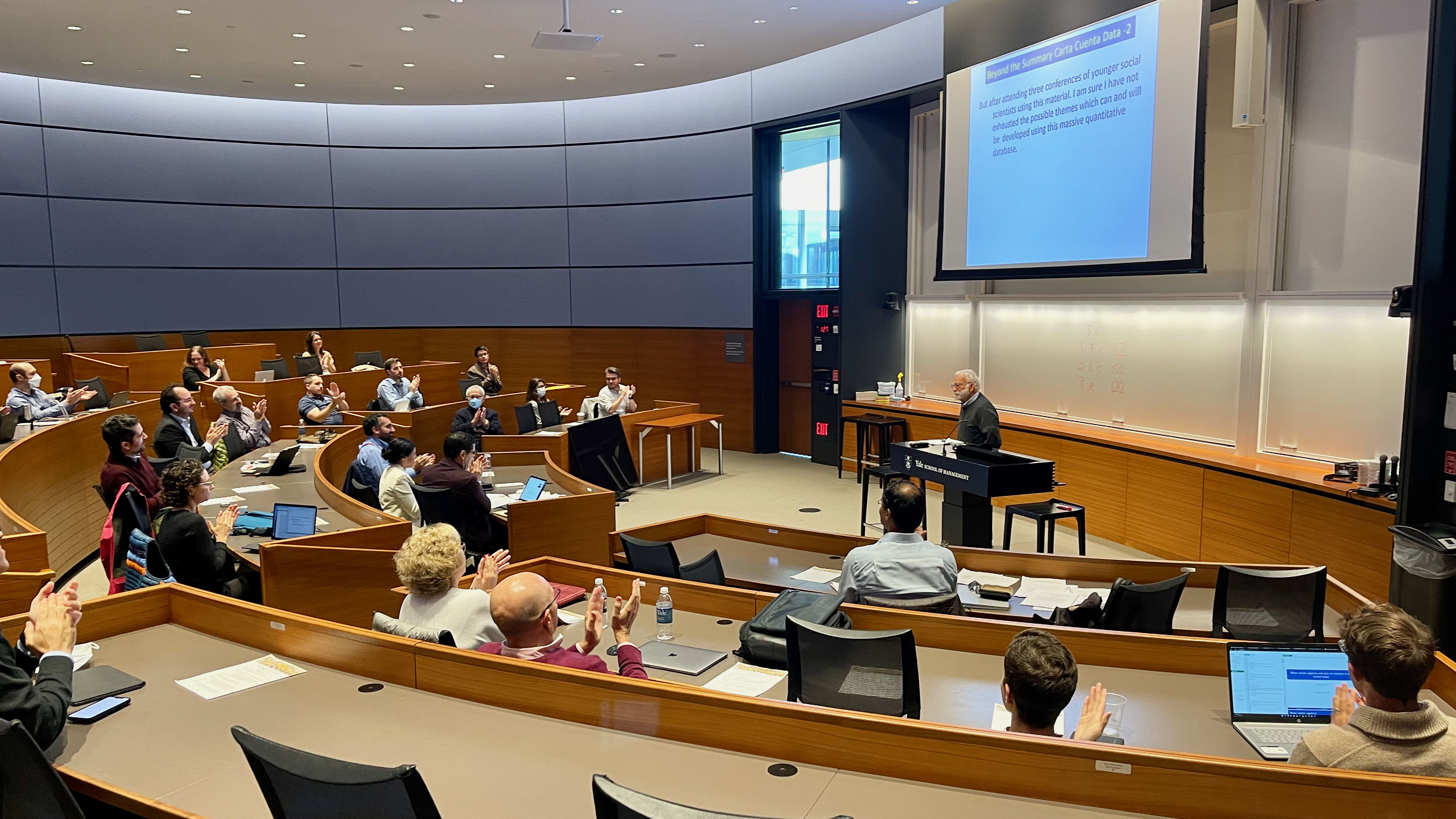Looking back on “The Columbian Shock: Explaining Long-Term Development of the Americas”
In an event on October 14-15, 2022, researchers shared findings on colonialism, development, and migration in the Americas through the lens of economic history.

Organizers of the Columbian Shock conference, Leticia Arroyo Abad (center) and José-Antonio Espín-Sánchez (R), during a Q&A.
The story of economic development in the Western Hemisphere is inextricably linked to its history, from the legacy of colonialism to centuries of migration to, from, and within the Americas. Two hundred years ago, the Spanish Empire spanned much of South, Central, and North America and the Caribbean, but today the region’s economic fortunes are wildly divergent. Why is per capita income just $1,300 in Bolivia but more than $34,000 in Texas (in 1995 PPP dollars), despite both being former Spanish colonies? How did colonial policies and migration patterns influence the region’s deep economic disparities, and how can economic history inform development efforts today?
These complex topics were the focus of “The Columbian Shock: Explaining Long-Term Development of the Americas,” a two-day conference we organized in collaboration with the Economic Growth Center on October 14-15, 2022. Bringing together scholars at the intersection of development economics and economic history, the event explored how Spanish America’s colonial experience sheds light on the causes and drivers of the region’s growth.

Leveraging historical data
To kick-start the event, we highlighted our ongoing multi-disciplinary project to digitize, transcribe, and analyze a large number of archival sources related to Spanish America’s economic history. Funded by the National Science Foundation in the United States, our vision for this project is to create three complementary datasets, comprising records of i) voluntary migrants who traveled to Spanish America from Europe and ii) enslaved people taken from Africa to Spanish America, as well as iii) a dataset that expands existing knowledge of Spanish America’s fiscal accounts – including territories known today as Florida, Louisiana, Central America, the Caribbean, Venezuela, and Colombia.
Over the course of two days, scholars presented papers on a range of topics that highlight the power of utilizing historical data for economic research. The sessions cut across two key categories: Spanish America’s long-term economic development and the critical role that migration has played throughout the region’s economic history. Below, we briefly describe the sessions.
The economic legacy of Spanish America
For our keynote presentation on the first day, we were fortunate to have Herbert Klein (Columbia University), an expert on the social, demographic, and economic history of Latin America, present an overview of scholarship on Spanish America’s fiscal records, which offer important and granular insights into the historic growth and decline of the region’s economies. Klein’s presentation also identified open questions in the literature and highlighted potential opportunities to answer them.
Digging deeper into the region’s historic trends, the first panel explored how Spanish reforms in the 18th century to establish tighter political and administrative colonial control – known as the “Bourbon reforms” – helped shape economic activity and long-term development.
- Sebastian Ellingsen (University of Bristol) discussed the effects on Transatlantic trade in the Americas, using georeferenced maritime data from historic logbooks to show how economic activity grew around new ports that emerged after the reforms.
- Felipe Caicedo Valencia (University of British Columbia) discussed the impact of the reforms on economic activity in the Americas, and how their centralizing nature affected state capacity to perform key functions (e.g., raising revenue, maintaining law and order) and social stability.
The next panel focused on indigenous communities in Mexico, linking their colonial experiences to long-run patterns of entrepreneurship and economic development.
- Saumitra Jha and Alberto Diaz-Cayeros (Stanford University) explored how indigenous communities that produced a certain red dye – one that is painstakingly extracted from cochineal insects – were more likely to survive the Mexican conquest and thrive during and after colonialism, creating links with international markets and maintaining higher standards of living than other indigenous communities.
- Luz Marina Arias (CIDE) focused on the economic outcomes of indigenous communities living in pueblos de indios (indigenous towns established by the Spaniards to organize native labor), finding that their proximity to colonial haciendas was associated with greater market access, higher literacy, and lower marginalization throughout the 20th century.
The role of migration
The event’s second day featured a keynote presentation by Blanca Sanchez-Alonso (University of San Pablo, CEU), who provided an overview of historical migration to the Americas, focusing on the ‘age of mass migration’ from 1870 to 1930 when approximately 13 million Europeans migrated to Latin America. Sanchez-Alonso discussed the historic facts and trends while highlighting important gaps in the scholarship.
Complementing this broad overview, a third panel explored subsequent waves of migration within and from Latin America, showcasing cutting-edge techniques to estimate the effects of migration.
- Brian Marein (University of Toronto) and Craig Palsson (Utah State University) presented their project on 20th century migration patterns from Haiti to the Dominican Republic (which subsequently passed policies to restrict Haitians’ entry and mobility), using a large and detailed microdata set compiled by digitizing all residency permit applications between 1940 and 1954.
- David Escamilla-Guerrero (University of St. Andrews) assessed the impact of the Mexican Revolution (1910-1920) on Mexican migration to the United States, finding that emigrants escaping civil war represented a supply-side shock to US border economies.
The event’s final panel focused on other aspects of migration to North America and was notable for the new research methods it highlighted.
- Yannay Spitzer (Hebrew University of Jerusalem) and Ariell Zimran (Vanderbilt University) used an innovative spatial model to test the diffusion hypothesis of European migration to North America, illustrating that mass migration from Italy in the late 19th and early 20th centuries was delayed by an initial lack of well-developed migration networks.
- Marco Tabellini (Harvard University) studied the Chinese Exclusion Act, which banned Chinese immigration to the US after 1882, to assess the short- and long-term impacts on local economies with important Chinese populations between 1870 and 1940 – finding that the Act lowered income for all workers and caused a sharp contraction in manufacturing, mining, and agriculture.
In addition to launching the dissemination of our archival project, the conference served as an important steppingstone to create a network of researchers interested in migration and long-term development in the Americas. By bringing together key scholars in overlapping fields from around the world, the gathering jumpstarted new collaborations and inspired all of us to think about new questions and innovative methodologies. We are grateful to the Economic Growth Center for supporting these efforts.